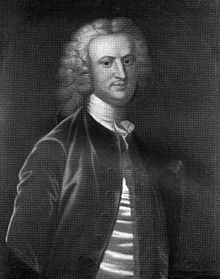Benedict Swingate Calvert
| Benedict Swingate Calvert | |
|---|---|

Benedict Swingate Calvert painted by John Wollaston c1753, five years after his marriage to Elizabeth Calvert. Collection of the Baltimore Museum of Art.
|
|
| Judge of the Land Office | |
|
In office 1755 – May 13, 1777 |
|
| Succeeded by | St George Peale |
| Personal details | |
| Born | January 27, 1722 England |
| Died | January 9, 1788 (aged 65) Maryland |
| Spouse(s) | Elizabeth Calvert |
| Relations |
Charles Calvert, 5th Baron Baltimore (father) Frederick Calvert, 6th Baron Baltimore (half brother) Henry Harford, 5th Proprietor Governor of Maryland (nephew) George I of Great Britain (grandfather) Charles II of England (great-great-grandfather) |
| Residence | Mount Airy |
| Occupation | planter, politician |
Benedict Swingate Calvert (January 27, 1722 – January 9, 1788) was a planter, politician and a Loyalist in Maryland during the American Revolution. He was the son of Charles Calvert, 5th Baron Baltimore, the third Proprietor Governor of Maryland (1699–1751), and may have been the grandson of King George I of Great Britain. His mother's identity is not known, though one source suggests Melusina von der Schulenburg, Countess of Walsingham. As he was illegitimate, he was not able to inherit his father's title or estates, which passed instead to his half brother Frederick Calvert, 6th Baron Baltimore (1731–1771). Benedict Calvert spent most of his life as a politician and planter in Maryland, though Frederick, by contrast, never visited the colony. Calvert became wealthy through proprietarial patronage and became an important colonial official, but he would lose his offices and his political power, though not his land and wealth, during the American Revolution.
Calvert was born Benedict Swinket in England on January 27, 1722, the illegitimate son of Charles Calvert, 5th Baron Baltimore, proprietary governor of the Province of Maryland. Although his birth year has been variously given as 1724 or 1730–1732, his own grave marker in the floor of the chancery of St. Thomas Episcopal Church in Croom, Maryland shows the 1722 date, and this would appear to be the most reliable evidence available.
Of course, the possibility exists that he may have deliberately falsified his birthdate in order to protect or obscure the identity of his mother. His mother's identity is not clear, but H. S. Lee Washington, writing in the New England Historic Genealogical Society Register in July 1950, suggests that she was Melusina von der Schulenburg, Countess of Walsingham. Melusina was the daughter of George I of England and his mistress, Melusine von der Schulenburg, Duchess of Kendal.
...
Wikipedia
